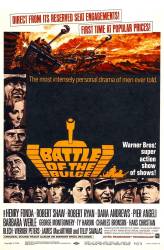Factual error: None of the German tanks are accurate representations of German WWII types. They are all post war US variants. ie. M47 Patton Tanks. [Still a mistake, but an elaboration: This is a common problem in depicting German tanks: few, if any, survived the war. The few museum examples wouldn't be released for movie work, and certainly WHERE, some 20 years after the war, would one find a brigade's worth of running Tiger II tanks? Never mind that Kampgruppe Pieper, which Hessler's command is loosely based on, actually used Mark IV and Panther tanks. There was one King Tiger battalion, and it was in reserve well behind KG Peiper. The M47s versus the M24 Chafees (mistakenly called "Shermans" at times) is a fairly accurate comparison of the respective sizes, firepower, and other combat capabilities of the respective tanks. Some other movies, like "Kelly's Heroes", have their "Tigers" mocked-up with sheet metal, wire mesh, and sacking over a different type of tank (in that case, T-34/85s of the Yugoslav army are mocked up as Tiger Is, a fairly decent job).]

Battle of the Bulge (1965)
Directed by: Ken Annakin
Starring: Henry Fonda, Robert Ryan, Robert Shaw, Dana Andrews
Continuity mistake: Near the beginning, Lt. Col. Daniel Kiley is in a scout plane and flies over Col. Martin Hessler, who is in a German staff car below. Kiley tells the pilot to "rev the engine" just above the car to entice Hessler to look up at them, so he can get a good photograph of his face. The plan works, and the ground level movie camera shows Hessler looking up. When the "photo from the air" is later developed, it shows Hessler looking up from the ground level camera's perspective, eyes focused about 30 degrees behind the airplane and giving a profile of Hessler.
Factual error: In the final scene showing the retreating German army, the land they are travelling over is fairly flat and devoid of trees. The Battle of the Bulge was fought in the thickly forested and hilly Ardennes Forest.
Trivia: Robert Shaw's character is based on Kampfgruppe Jochim Peiper of 1st SS Leibstandart Adolph Hitler, Panzer Division. Peiper was a ruthless but extremely effective officer who had learnt his trade in death on the Russian front. Peiper survived the battle and the war and although he was initially sentenced to death for his part in the Malmedy massacre his sentence was commuted. He was killed in France in 1976 when his house was firebombed in a revenge attack.
Trivia: The tank models used by the German commanders at their headquarters look just like the actual King Tiger and Sherman tanks used by both sides during the late part of the war, whereas the tanks used in the film look nowhere near like actual German and American tanks used during the battle.
Trivia: The American uniform-disguised German troop is inspired by the actual operation "Greif" led by Otto Skorzeny. It did however not happen as in the movie; they where not dropped in parachutes but used captured jeeps. Only very few came through and even fewer had any success. Skorzeny had very little time for preparations, The shortage of men with language skills at the desired level was severe and he considered aborting the operation because several conditions of the plan had not been met. Rumours about the target of the task force were encouraged, one being that their target was Eisenhower's HQ in Paris.
Col. Martin Hessler: Germans are still the best toy makers in the World.
Col. Martin Hessler: They have the fuel and planes to fly Cake over the Atlantic Ocean.
Col. Martin Hessler: Do you know what this means?
Cpl. Conrad: This new command is an illusion. Give it up.
Col. Martin Hessler: I am Martin Hessler. Four years ago, my panzers overran Poland in one week, that was no illusion. In 39 days, my tanks smashed all the way to Paris, that was no illusion. I conquered the Crimea, that was no illusion. Today, I was given a brigade of Tiger tanks. When I have a brigade of tanks, that is reality.
Question: What is the English translation of the panzer song when Hessler meets his commanders?
Join the mailing list
Separate from membership, this is to get updates about mistakes in recent releases. Addresses are not passed on to any third party, and are used solely for direct communication from this site. You can unsubscribe at any time.
Check out the mistake & trivia books, on Kindle and in paperback.




Answer: I believe that in the film, the men are repeatedly singing only the first verse. However, I have found the complete translation of all five verses and posted it here: "The Panzer Song (Panzerlied) " 1: Whether in storm or in snow /Whether the sun smiles on us/ The day blazing hot /Or the night ice cold/ Our faces are dusty/ But our spirits are cheerful /Yes, our spirits are cheerful/ Our tank roars Into the windstorm. 2: With thundering engines /As fast as lightning/ We engage the enemy/ Safe in our tanks/ Far ahead of our comrades /In battle we stand alone/ Yes, stand alone Into enemy territory. 3: If an enemy tank /Appears in our sight /We ram throttles full/ And close with the foe! /We give our lives freely /For the army of our realm/ Yes, the army of our realm/ To die for Germany Is our highest honour. 4: With barriers and tanks/ Our opponent tries to stop us /We laugh at his efforts/ And travel around them/And when the guns threatingly/ Hide in the yellow sand/ Yes, in the yellow sand/ We search for paths /No-one else has found. 5: And if some day /Faithless luck abandons us /And we can't return home/ The deadly bullet strikes/ And fate calls us /Yes, fate calls us /Then our tank is An honourable grave. Source: http://defence.pk/threads/german-ww2-and-pre-ww2-march-songs.146130.
Michael Albert